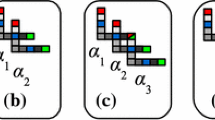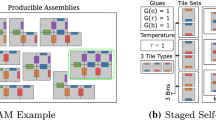Abstract
Self-assembly is the process in which small and simple components assemble into large and complex structures without explicit external control. The nubot model generalizes previous self-assembly models (e.g. the abstract Tile Assembly Model (aTAM)) to include active components which can actively move and undergo state changes. One main difference between the nubot model and previous self-assembly models is its ability to perform exponential growth with respect to time. In the paper, we study the problem of finding a minimal set of features in the nubot model which allows exponential growth to happen. We only focus on nubot systems which assemble a long line of nubots with a small number of supplementary layers. We prove that exponential growth is not possible with the limit of one supplementary layer and one state-change per nubot. On the other hand, if two supplementary layers are allowed, or the disappearance rule can be performed without a state change, then we can construct nubot systems which grow exponentially.














Similar content being viewed by others
References
Adleman L, Cheng Q, Goel A, Huang M-D (2001) Running time and program size for self-assembled squares. In: Proceedings of the 33rd annual ACM symposium on theory of computing, pp 740–748
Barish RD, Rothemund PWK, Winfree E (2005) Two computational primitives for algorithmic self-assembly: copying and counting. Nano Lett 5(12):2586–2592
Bishop J, Klavins E (2007) An improved autonomous DNA nanomotor. Nano Lett. 7(9):2574–2577
Chen H-L, Doty D, Holden D, Thachuk C, Woods D, Yang C-T (2014) Fast algorithmic self-assembly of simple shapes using random agitation. Springer, Cham, pp 20–36
Chen H-L, Schulman R, Goel A, Winfree E (2007) Error correction for DNA self-assembly: preventing facet nucleation. Nano Lett 2913–2919
Cheng Q, Goel A, Moisset P (2014) Optimal self-assembly of counters at temperature two. In: Proceedings of the 1st conference on foundations of nanoscience: self-assembled architectures and devices, pp 62–75
Chin Y-R, Tsai J-T, Chen H-L (2017, September) A minimal requirement for self-assembly of lines in polylogarithmic time. In: Proceedings of the 23rd international conference on DNA computing and molecular programming (DNA 23), pp 139–154
Dietz H, Douglas S, Shih W (2009) Folding DNA into twisted and curved nanoscale shapes. Science 325:725–730
Ding B, Seeman N (2006) Operation of a DNA robot arm inserted into a 2D DNA crystalline substrate. Science 384:1583–1585
Dirks RM, Pierce NA (2004) Triggered amplification by hybridization chain reaction. Proc Natl Acad Sci 101(43):15275–15278
Doty D (2010) Randomized self-assembly for exact shapes. SIAM J Comput 39(8):3521–3552
Douglas S, Dietz H, Liedl T, Hogberg B, Graf F, Shih W (2009) Self-assembly of DNA into nanoscale three-dimensional shapes. Nature 459:414–418
Fu T-J, Seeman NC (1993) DNA double crossover structures. Biochemistry 32:3211–3220
Green S, Bath J, Turberfield A (2008) Coordinated chemomechanical cycles: a mechanism for autonomous molecular motion. Phys Rev Lett 101:238101
Kao M-Y, Schweller R (2006) Reducing tile complexity for self-assembly through temperature programming. In: Proceedings of the 17th annual ACM-SIAM symposium on discrete algorithms, pp 571–580
Lagoudakis M, LaBean T (1999) 2D DNA self-assembly for satisfiability. In: Proceedings of the 5th DIMACS workshop on DNA based computers in DIMACS series in discrete mathematics and theoretical computer science, vol 54, pp 141–154
Nubot-simulator (2014) https://github.com/domardfern/nubot-simulator
Pei R, Taylor S, Stojanovic M (2007) Coupling computing, movement, and drug release
Reif JH, Sahu S (2007, June) Autonomous programmable DNA nanorobotic devices using DNAzymes. In: Proceedings of the thirteenth international meeting on DNA based computers, Memphis, TN
Rothemund P, Winfree E (2000) The program-size complexity of self-assembled squares (extended abstract). In: Proceedings of the 32nd annual ACM symposium on theory of computing, pp 459–468
Rothemund PWK (2006) Folding DNA to create nanoscale shapes and patterns. Nature 440:297–302
Rothemund PWK, Papadakis N, Winfree E (2004) Algorithmic self-assembly of DNA Sierpinski triangles. PLoS Biol 2:424–436
Seelig G, Soloveichik D, Zhang D, Winfree E (2006) Enzyme-free nucleic acid logic circuits. Science 314:1585–1588
Sherman WB, Seeman NC (2004) A precisely controlled DNA bipedal walking device. Nano Lett 4:1203–1207
Shih WM, Quispe JD, Joyce GFA (2004) A 1.7-kilobase single-stranded DNA that folds into a nanoscale octahedron. Nature 427:618–621
Shin J-S, Pierce NA (2004) A synthetic DNA walker for molecular transport. J Am Chem Soc 126:10834–10835
Soloveichik D, Winfree E (2007) Complexity of self-assembled shapes. SIAM J Comput 36:1544–1569
Tian Y, He Y, Chen Y, Yin P, Mao C (2005) A DNAzyme that walks processively and autonomously along a one-dimensional track. Angew Chem 44:4355–4358
Venkataraman S, Dirks RM, Rothemund PWK, Winfree E, Pierce NA (2007) An autonomous polymerization motor powered by DNA hybridization. Nat Nanotechnol 2:490–494
Win MN, Smolke CD (2008) Higher-order cellular information processing with synthetic rna devices. Science 322(5900):456
Winfree E (1998) Algorithmic Self-Assembly of DNA. PhD thesis, California Institute of Technology, Pasadena
Winfree E, Liu F, Wenzler L, Seeman N (1998) Design and self-assembly of two-dimensional DNA crystals, 6 pages. Nature 394:539–544
Woods D, Chen H-L, Goodfriend S, Dabby N, Winfree E, Yin P (2013) Active self-assembly of algorithmic shapes and patterns in polylogarithmic time. In: Proceedings of the 4th conference on innovations in theoretical computer science, ITCS'13, pp 353–354
Yin P, Choi HMT, Calvert CR, Pierce NA (2008) Programming biomolecular self-assembly pathways. Nature 451:318–322
Yin P, Turberfield AJ, Sahu S, Reif JH (2004, June) Designs for autonomous unidirectional walking DNA devices. In: Proceedings of the 10th international meeting on DNA based computers, Milan, Italy
Yurke B, Turberfield A, Mills A Jr, Simmel F, Neumann J (2000) A DNA-fuelled molecular machine made of DNA. Nature 406:605–608
Zhang DY, Turberfield AJ, Yurke B, Winfree E (2007) Engineering entropy-driven reactions and networks catalyzed by DNA. Science 318:1121–1125
Zhang Y, Seeman N (1994) Construction of a DNA-truncated octahedron. J Am Chem Soc 116(5):1661
Author information
Authors and Affiliations
Corresponding author
Additional information
H.-L. Chen: Research supported in part by MOST Grant Number 104-2221-E-002-045-MY3.
Rights and permissions
About this article
Cite this article
Chin, YR., Tsai, JT. & Chen, HL. A minimal requirement for self-assembly of lines in polylogarithmic time. Nat Comput 17, 743–757 (2018). https://doi.org/10.1007/s11047-018-9695-9
Published:
Issue Date:
DOI: https://doi.org/10.1007/s11047-018-9695-9




